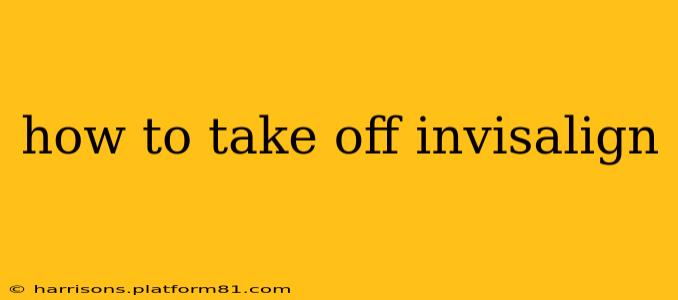Invisalign aligners offer a discreet way to straighten your teeth, but knowing how to properly remove and reinsert them is crucial for their effectiveness and your oral health. This guide will walk you through the process, addressing common questions and concerns.
How Do I Take Out My Invisalign Aligners?
Removing your Invisalign aligners is surprisingly straightforward once you get the hang of it. Here's a step-by-step guide:
-
Wash your hands: This is crucial to maintain hygiene and prevent transferring germs to your aligners or mouth.
-
Choose a starting point: Typically, it's easiest to start with either your upper or lower aligners. Experiment to find what works best for you.
-
Get a grip: Use your thumbs to gently press on the back of the aligner, near your back molars.
-
Gently pull: Slowly and gently pull the aligner away from your teeth. Avoid jerking or pulling too hard, as this could damage the aligners or your teeth.
-
Clean your aligners: Once removed, rinse your aligners thoroughly under lukewarm water. This removes food particles and bacteria. More thorough cleaning methods will be discussed below.
-
Repeat for the other aligner: Follow the same steps to remove the other aligner.
How Tight Should My Invisalign Aligners Feel When Removing Them?
Your Invisalign aligners should fit snugly but not painfully tight. If they're extremely difficult to remove, it could be a sign that you haven't worn them for the recommended time or that they're damaged. Contact your orthodontist immediately if you experience significant difficulty removing your aligners or persistent discomfort.
What if I Can't Get My Invisalign Aligners Off?
Sometimes, particularly with newer aligners, they can feel quite snug. If you're struggling, try:
- Using a gentle rocking motion: Instead of just pulling, try gently rocking the aligner back and forth to help break the seal.
- Using your fingers: Sometimes using your index finger and thumb, rather than just your thumbs, provides a better grip.
- Trying different angles: Experiment with different ways of gripping the aligner.
- Asking for help: If you're still having trouble after trying these techniques, don't hesitate to reach out to your orthodontist's office for assistance. They can provide advice or potentially adjust your aligners.
How Often Should I Take Out My Invisalign Aligners?
You should remove your Invisalign aligners for eating, drinking (anything other than plain water), and brushing and flossing your teeth. This is essential to maintain proper oral hygiene and prevent staining or damage to your aligners. Aim to wear your aligners for at least 20-22 hours per day for optimal results.
How Do I Clean My Invisalign Aligners?
Cleaning your Invisalign aligners is crucial to prevent bacteria buildup and maintain their clarity. Here are some methods:
- Rinsing with water: Rinse your aligners thoroughly with lukewarm water after each removal.
- Using a special cleaning solution: Your orthodontist may recommend a specific cleaning solution or tablets designed for Invisalign aligners. Follow the instructions carefully.
- Brushing gently: Use a soft-bristled toothbrush and lukewarm water to gently brush the aligners. Avoid abrasive cleaners or toothpaste, as this can scratch the plastic.
- Storing appropriately: Store your aligners in their provided case when not in use to protect them from damage and keep them clean.
What Happens If I Don't Wear My Invisalign Aligners Enough?
Not wearing your Invisalign aligners for the recommended amount of time will significantly slow down your treatment progress. It can also lead to discomfort and potentially require adjustments to your treatment plan. Always prioritize wearing your aligners according to your orthodontist’s instructions.
Remember, always consult your orthodontist or their staff if you have any concerns or experience problems with your Invisalign aligners. They are the best resource for advice tailored to your specific situation.
